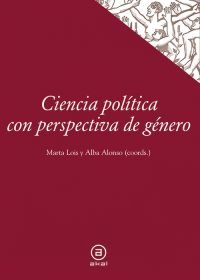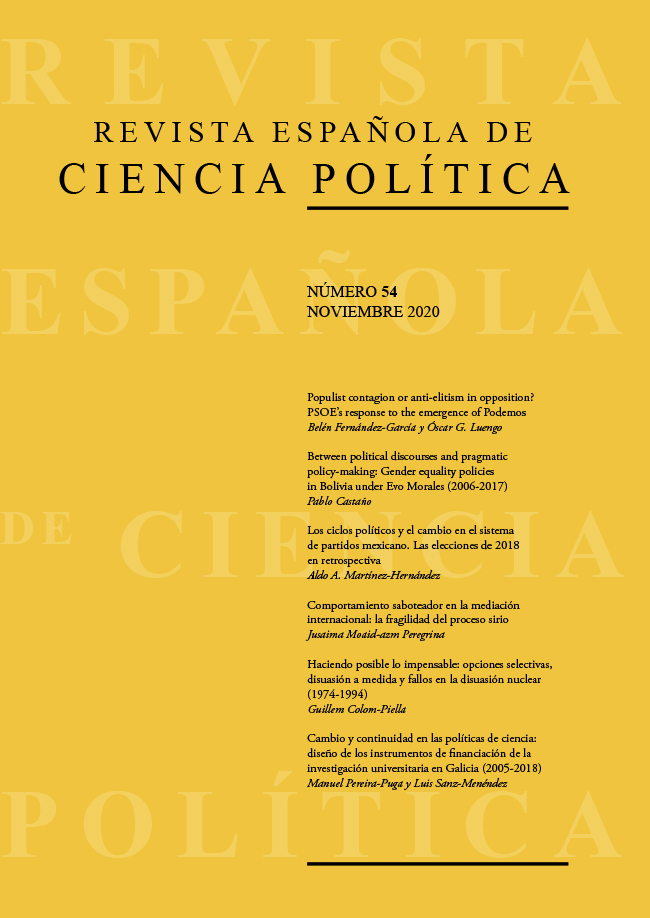Material Docente
En este apartado se puede encontrar referencias bibliográficas sobre manuales, libros y artículos que abordan la perspectiva de género en la docencia y/o sesgos de género en la disciplina de Ciencia Política.

Manuales y libros
- Aguado-Peláez, Delicia y Martínez García, Patricia (2018): Guía Evaluación. Herramientas Prácticas para la Evaluación de Políticas de Participación del Ayuntamiento de Pamplona. Ayuntamiento de Pamplona y Parte Hartuz. Recurso online: http://participa.pamplona.es/wp-content/uploads/sites/2/2018/11/GUIA_EVALUACION.pdf
- Lois, Marta y Alba Alonso (eds.) (2014), Ciencia Política con Perspectiva de Género, Madrid: Akal
- Espinosa Fajardo, Julia ( 2018). Guía de género para políticas públicas más transformadoras. Barcelona: Oxfam Intermón.
- Kantola, Johanna y Emanuela Lombardo. 2017. Gender and Political Analysis. Basingstoke: Palgrave.
- Waylen, Georgina et al (2014). The Oxford Handbook of Gender and Politics. Oxford: Oxford University Press.
- Ortiz Monera, Rosa M. y Anna M. Morero Beltrán (2018). Sociologia, Economia i Ciència Política: guies per a una docència universitària amb perspectiva de gènere. Castelló de la Plana: Xarxa Vives d’Universitats. Recurso online: https://www.vives.org/book/sociologia-economia-i-ciencia-politica-guies-per-a-docencia-universitaria-amb-perspectiva-de-genere/
- Verge, Tània (2016). “The virtues of engendering quantitative methods courses”. PS: Political Science & Politics 49 (3): 550–553.
- Symposium ‘Mainstreaming Gender in the Teaching and Learning of Politics’, edited by Brooke Ackerly and Liza Mügge. DOI: 10.1017/S1049096516000962
- Guía temática de Ciencia Política con perspectiva de género, Biblioteca-CRAI de la Universitat Pompeu Fabra:
Estudiantes: https://guiesbibtic.upf.edu/cpis/perspectiva-genere
Profesorado: https://guiesbibtic.upf.edu/cpis/perspectiva-genere-docencia

Artículos en revistas de Ciencia Política
- Abels, Gabriele (2016). “The gender gap in political science education in Germany”. European Political Science 15 (3): 322–331.
- Ackerly, B., & Mügge, L. (2016). Introduction. PS: Political Science & Politics, 49(3), 541-545.
- Alexander-Floyd, N. (2015). Women of Color, Space Invaders, and Political Science: Practical Strategies for Transforming Institutional Practices. PS: Political Science & Politics, 48(3), 464-468.
- Alonso, Alba and Emanuela Lombardo (2016). “Ending ghettoization? mainstreaming gender in Spanish political science education”. European Political Science 15 (3): 229–302.
- Anonymous (2014). No Shortcuts to Gender Equality: The Structures of Women’s Exclusion in Political Science. Politics & Gender, 10(3), 437-447.
- Arbuckle, Julianne y Benne D. Williams. 2003. “Students’ Perceptions of Expressiveness: Age and Gender Effects on Teacher Evaluations”, Sex Roles, 49 (9/10): 507–16.
- Atchison, Amy L. 2013. “The Practical Process of Gender Mainstreaming in the Political Science Curriculum”. Politics & Gender 9 (2): 228-235.
- Atchison, A. (2016). Bringing Women In: Gender Mainstreaming in Introduction to Political Science. PS: Political Science & Politics, 49(3), 546-549.
- Bates, Stephen, Laura Jenkins y Zoe Pfaelger. 2012. “Women in the profession: The composition of UK Political Science departments by sex”, Politics, 32 (3): 139–52.
- Beckwith, K. (2015). State, Academy, Discipline: Regendering Political Science. PS: Political Science & Politics, 48(3), 445-449.
- Bedolla, L. (2014). How an Intersectional Approach Can Help to Transform the University. Politics & Gender, 10(3), 447-455.
- Bonjourliza, Saskia and Müggeconny Roggeband (2016). “Lost in the mainstream? gender in Dutch political science education”. European Political Science 15 (3): 303–313.
- Brandes, Lisa, Eloise Buker, Susan Burgess, Constance Cook, Janet Flammang, Shirley Geiger, Susan Okin, Bang-Soon Yoon, and Martha Ackelsberg, Chair of the Women’s Caucus. (2001). The Status of Women in Political Science: Female Participation in the Professoriate and the Study of Women and Politics in the Discipline: Committee on the Status of Women in the Profession. PS: Political Science & Politics 34(2): 319-326.
- Breuning, Marijke and Kathryn Sanders (2007). Gender and Journal Authorship in Eight Prestigious Political Science Journals. PS: Political Science and Politics 40 (2): 347-351.
- Briggs, J. and Harrison L. (2015) ‘The status of women in UK political science. European Political Science 14 (2): 105-115.
- Carpenter, Charli. 2007. “Introduction”. International Studies Perspectives 8 (3): 315–16.
- Cassese, Erin C. and Angela L. Bos. 2013. “A Hidden Curriculum? Examining the Gender Content in Introductory-Level Political Science Textbooks”. Politics & Gender 9 (2): 214-223.
- Childs, S. and Krook M.L. (2006) ‘Gender and Politics: The State of the Art’, Politics 26(1): 18–28.
- Cooperman, R., Patterson, M., & Rigelhaupt, J. (2016). Teaching Race and Revolution: Doing Justice to Women’s Roles in the Struggle for Civil Rights. PS: Political Science & Politics, 49(3), 558-561.
- Curtin, Jennifer (2013). Women and Political Science in New Zealand. Political Science 65 (1): 63-83.
- Dahlerup, Drude (2010) ‘The Development of gender and politics as a new research field within the framework of the ECPR’ European Political Science 9, 85–98.
- Daniels, C. (2014). Transforming a Department, Transforming a Discipline. Politics & Gender, 10(3), 464-473.
- Doherty, L. (2013). Gender Mainstreaming in Political Science Experiential Learning Programs. Politics & Gender, 9(2), 223-227
- Elison, Sonja. 1997. “Integrating Women into the Study of European Politics.” PS: Political Science & Politics 30 (2): 202–4.
- Evans, H.K. and Moulder, A. (2011) ‘Reflecting on a Decade of Women’s Publications in Four Top Political Science Journals’, PS: Political Science & Politics 44(4): 793-798.
- Evans, Elizabeth and Fran Amery (2016). “Gender and politics in the UK: banished to the sidelines”. European Political Science 15 (3): 314–321.
- Evans, R. (2016). Men are from Mars, Women are from Venus, and Zombies are from … Feminist Theories of International Politics and Zombies. PS: Political Science & Politics, 49(3), 554-557.
- Ford, Lynne E. (2016). Two steps forward, one step back? Strengthening the foundations of women’s leadership in higher education. Politics, Groups, and Identities 4 (3): 499-512.
- Foster, Emma, Peter Kerr, Anthony Hopkins, Christopher Byrne, and Linda Ahall (2013) ‘The personal is not political: At least in the UK’s top politics and IR departments’, The British Journal of Politics & International Relations, 15 (4), 566–585.
- Gruberg, Martin. 1994. “Incorporating a Women’s Studies Dimension into Mainstream Political Science Courses.” PS: Political Science & Politics 27 (4): 717–18.
- Hawkesworth, Mary. 2005. “Engendering Political Science: An Immodest Proposal.” Politics & Gender 1(1): 141156.
- Hero, R. (2015). Reflections on “How Political Science Can Be More Diverse”. PS: Political Science & Politics, 48(3), 469-471
- Hesli Claypool, Vicki & Carol Mershon (2016). Does diversity matter? Evidence from a survey of political science faculty. Politics, Groups, and Identities 4 (3): 483-498.
- Kantola, Johanna. 2008. “’Why do all the women disappear?’ Gendering processes in a political science department”. Gender, Work and Organization 15 (2): 202-225.
- Kelley, R.M., Williams, L.M. and Fisher, K. (1994) ‘Women & Politics: an assessment of its role within the discipline of Political Science’, Women & Politics 14(4): 3-18.
- Kelly, R.M. and Fisher, K. (1993) ‘An Assessment of Articles about Women in the “Top 15” Political Science Journals’. PS: Political Science & Politics 26(3): 544-558.
- Kittilson, M. (2015). Advancing Women in Political Science: Navigating Gendered Structures of Opportunity. PS: Political Science & Politics, 48(3), 450-453.
- Lovenduski, Joni. 1998. “Gendering Research in Political Science”. Annual Review of Political Science 1: 333-56.
- Lyle-Gonga, Marsha. 2013. “A Critical Analysis of Gender Mainstreaming”. Politics & Gender 9: 209-213.
- Macaulay, F. (2016). Heart, Head, and Hands: Intercultural, Experiential, and Applied Gender Learning in a Peace Studies Department. PS: Political Science & Politics, 49(3), 566-570.
- Maliniak, Daniel, Ryan Powersa y Barbara F. Walter. 2013. “The gender citation gap in International Relations”, International Organization, 67 (4): 889–922.
- McClain, Paula D., Gloria Y. A. Ayee, Taneisha N. Means, Alicia M. Reyes-Barriéntez & Nura A. Sediqe (2016). Race, power, and knowledge: tracing the roots of exclusion in the development of political science in the United States. Politics, Groups, and Identities 4 (3): 467-483.
- Matthes, Melissa, 2013. “Conclusion and Rejoinders”. Politics & Gender 9 (2): 235-238.
- Mazur, A. (2016). Mainstreaming Gender in Political Science Courses: The Case of Comparative Public Policy. PS: Political Science & Politics, 49(3), 562-565
- Mershon, C., & Walsh, D. (2014). Introduction. Politics & Gender, 10(3), 432-437.
- Mershon, C., & Walsh, D. (2015). How Political Science Can Be More Diverse: Introduction. PS: Political Science & Politics, 48(3), 441-444.
- Mershon, C., & Walsh, D. (2015). Organizing Women: Diversifying Leadership and Addressing Discrimination in Political Science Departments. PS: Political Science & Politics, 48(3), 459-463.
- Mershon, Carol & Denise Walsh (2016). Diversity in political science: why it matters and how to get it. Politics, Groups, and Identities 4 (3): 462-466.
- Mertus, Julie. 2007. “Teaching Gender in International Relations.” International Studies Perspectives 8 (3): 323–25.
- Monroe, Kristen, Saba Ozyurt, Ted Wrigley y Amy Alexander. 2008. “Gender equality in academia: Bad news from the trenches and some possible solutions”, Perspectives on Politics, 6(2): 215–32.
- Monroe, K.R., Choi, J., Howell, E., Lampros-Monroe, C., Trejo, C. and Perez V. (2014) ‘Gender Equality in the Ivory Tower, and How Best to Achieve It’, PS: Political Science & Politics 47(2): 418-426.
- Mitchell, S., & Hesli, V. (2013). Women Don’t Ask? Women Don’t Say No? Bargaining and Service in the Political Science Profession. PS: Political Science & Politics, 46(2), 355-369.
- Mügge, Liza, Elizabeth Evans, and Isabelle Engeli (2016). “Introduction: gender in european political science education – taking stock and future directions”. European Political Science 15 (3): 281–291.
- Sauer, Birgit (2016). “Austrian exceptionalism? insights from a huge department in a small country”. European Political Science 15 (3): 332–342.
- Sawer, Marian. 2004. “The Impact of Feminist Scholarship on Australian Political Science.” Australian Journal of Political Science 39: 553–66.
- Siim, Birte (2004) ‘Towards a contextual and gender sensitive European political science?’ European Political Science 3(2): 97-101.
- Sinclair-Chapman, V. (2015). Leveraging Diversity in Political Science for Institutional and Disciplinary Change. PS: Political Science & Politics, 48(3), 454-458.
- Smith, Nicola and Donna Lee (2015) ‘What’s Queer About Political Science?’ British Journal of Politics and International Relations 17 (1), 49–63.
- Smooth, Wendy G. (2016). Intersectionality and women’s advancement in the discipline and across the academy. Politics, Groups, and Identities 4 (3): 513-528.
- Tetreault¸ Mary Ann. 2008. “Women in International Relations.” Politics & Gender 4: 144–56.
- Timperley, Claire. 2013. “Women in the Academy: Key studies on gender in political science”, Political Science, 65 (1): 84–104.
- Tolleson-Rinehart, Sue y Susan Carroll. 2006. “‘Far from ideal’: The gender politics of political science”, American Political Science Review 100 (4): 507–13.
- Valiente, Celia. 2002. “An Overview of Research on Gender in Spanish Society”, Gender and Society, 16 (6): 767–92.
- Verge, T. (2016). The Virtues of Engendering Quantitative Methods Courses. PS: Political Science & Politics, 49(3), 550-553.
- Verge, Tània & Alba Alonso (2019). “La ceguera al género en el curriculum de Ciencia Política”. Revista Internacional de Sociología 77 (3): e135.
- Wahlke, John C. (1991). “Liberal Learning and the Political Science Major: A Report to the Profession”. PS: Political Science & Politics 24 (1): 48–60.
- Williams, H., Bates, S., Jenkins, L., Luke, D. and Rogers, K. (2015) ‘Gender and Journal Authorship: An Assessment of Articles Published by Women in Three Top British Political Science and International Relations Journals’, European Political Science 14(2): 116-130.